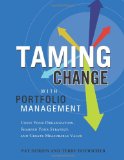Taming Change with Portfolio Management
This blog is reader-supported. When you purchase something through an affiliate link on this site, I may earn some coffee money. Thanks! Learn more.

Pat Durbin and Terry Doerscher have written a definitive guide to modern portfolio management. It covers all the basics like managing a portfolio of projects with common resources and funding but it takes it to the next level. “We are approaching these subjects from a broader perspective — applying portfolio management to changes that impact you on an organizational level to effectively manage these change events, deliver exceptional growth, and create measurable value,” they write.
Essentially, Durbin and Doerscher say that you can run your whole business on a portfolio management approach. Why do we need a model of portfolio management that is so broad? As a result of changing business models we have ended up with organizations that need to be more flexible.
The authors say that using portfolio management as an overarching business principle means that you can:
Implement the right decision-making tools
- Understand and demonstrate how individuals and their actions fit within the big picture
- Measure and assess effectiveness
- Improve performance in the future.
It is a deeper look at portfolios than anything I have read before, including Simon Moore’s excellent book. Moore looks at how to set up and create strategic project portfolios, but Durbin and Doerscher consider the change and impact of portfolios on organizations.
This approach does make it an interesting read for a project manager, although PM’s will find it less relevant than Moore’s book to their day-to-day work.
Managers of all kinds in small companies will also find it pretty heavy going, as a lot of the principles relate to large organizations. You can’t have a corporate portfolio if you’re a one-person project management consultancy.
However, a lot of the thinking will be the same, even if it doesn’t translate into teams of portfolio managers. You still need a way to assess individual investment opportunities, manage an investment portfolio, asses and manage the work coming in and a delivery function to implement the work.
For all that Taming Change is aimed at keeping financial decisions on track and helping companies get the best return in a structured way, it isn’t supposed to be a radical rethink of the portfolio model. Instead, it’s evolved thinking — taking the concepts to the next level to get even more value out of them.
Conceptually there is a lot of stuff in here, but some of the detail is worth a mention too. The bit on key performance indicators in the section on the operational planning process is excellent. There is a strong focus on proactivity: “Leadership has another level at its disposal to manage capacity : timing. Operational planning may need to consider slowing down, spreading out, or rearranging how the total portfolio of initiatives is slated for execution,” the authors write.
Chapter 15 points out that portfolio management processes by themselves deliver nothing, and that you have to pair them with the delivery of products, services and assets.
Taming Change is a mixture of practical and conceptual ways to approach portfolio management. I didn’t find it an easy read, but it is challenging. You didn’t expect it to be easy to get your organization to deliver repeatable results, did you?
Read my summary of the top 10 books on change management.
